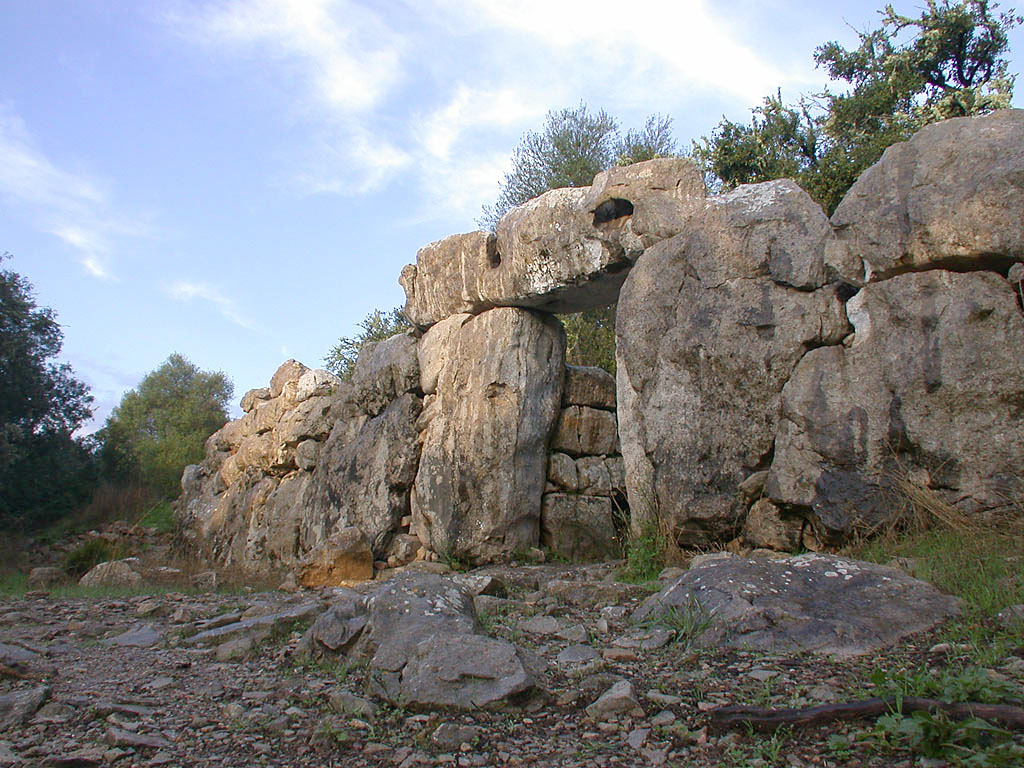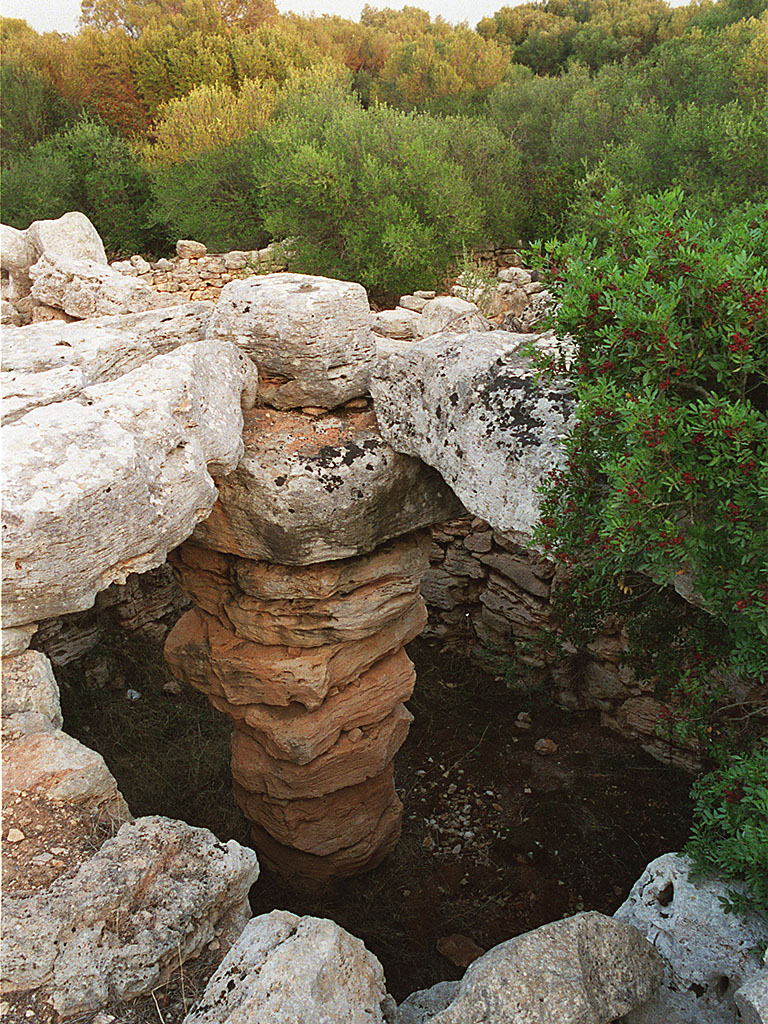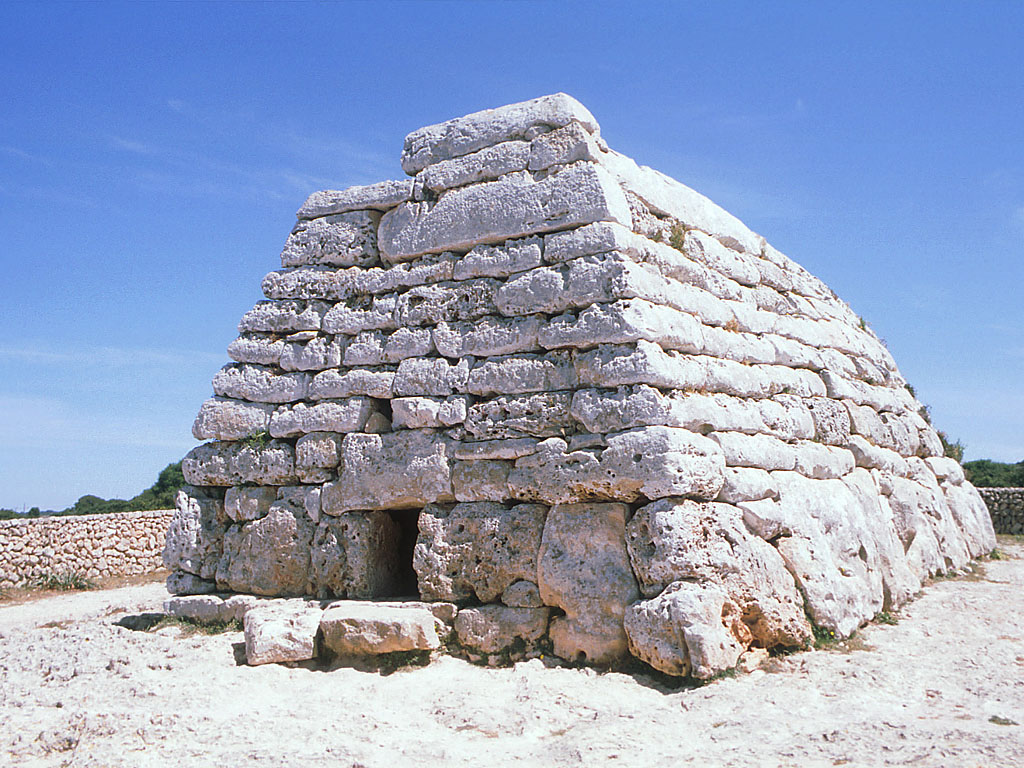Origins
Up until the end of the 20th century, it was theorized that the Talaiotic Culture arose out of interaction between new peoples from the eastern
History
The first evidence indicating the development of this culture appeared at the end of the 2nd millennium BC, when island society was threatened by population increases, inefficient food production, and limited living space. Agricultural techniques that the first inhabitants had brought with them a millennium before in thePeriodization
It is important to bear in mind that the cultural complex known as ''Talayotic'' spans a very broad time frame, and there is no unanimous agreement among researchers regarding the systematization of its phases and chronology. Furthermore, this culture displays distinct and significant differences between Mallorca and Menorca, for example, in terms of its chronological development. One of the first authors to address the material remains of this culture wasInterpretative and chronological proposals
Proposal from the Museum of Menorca
One of the chronological frameworks for the Talayotic period in Menorca has been proposed by Lluís Plantalamor. According to this author, around 1500 BCE a significant cultural shift occurred due to the arrival of foreign people to the island of Menorca. Previous ways of life began to be abandoned, and the first clusters of houses and villages appeared, with a clear emphasis on defense (including walls and ''talayots''), social hierarchy, communal labor specialization, and a gradual increase in the complexity of rituals and religious beliefs. Four distinct periods are identified:Talayotic I (1500–1000 BCE)
A transitional period. Burial systems from the previous era persist (notably burial ''navetas''), but new architectural models are introduced due to the community’s defensive needs (''talayots'' and walls). Pottery production becomes more refined, and bronze metallurgy is introduced. The most characteristic monument of the new culture is the ''talayot'', which can be defined as a large truncated conical tower (truncated pyramidal in Mallorca), built with several concentric rings of large stones filled with smaller rocks. Unlike those in Mallorca, ''talayots'' in Menorca usually lack interior chambers.Talayotic II (1000–700 BCE)
Construction systems from the pre-Talayotic period are abandoned, and large urban settlements develop. Social stratification and division of labor are reinforced, reflecting a fully urban cultural stage. From this period onward, a unique type of sanctuary appears in the Mediterranean: the ''taulas''. These are enclosures with a roughly horseshoe-shaped floor plan, surrounded by cyclopean walls interspersed with columns. At their center stands a large monolithic pillar with a rectangular base, topped with a wide, flat capital—evoking the image of a table.Talayotic III (700–300 BCE)
Increasing commercial contact with Greeks, Phoenicians, and Carthaginians leads the Talayotic people to reinforce their villages with additional defensive structures, such as bastions and watchtowers. New architectural styles are introduced, including circular houses with central courtyards. Luxurious bronze items and iron weaponry also begin to appear.Talayotic IV (400/300–123 BCE)
Trade with the great seafaring civilizations of the Mediterranean intensifies. The exchange evolves from rare prestige goods (likely used to elevate Talayotic chieftains) to the transfer of essential goods and foodstuffs. Rome emerges as a dominant power, which adversely affects Menorca as it becomes increasingly marginalized after the defeat of its Carthaginian ally. Inland villages are destroyed and rebuilt during the Punic Wars, eventually falling into decline. Talayotic sanctuaries (''taulas'') are abandoned. In contrast, Talayotic settlements near major natural harbors gain prominence. The continued presence of foreign merchants attracts late Talayotic communities closer to their docking points.Chronological proposal from the Autonomous University of Barcelona
This proposal, developed by the Mediterranean Social Archaeology Group led by V. Llull, suggests that the first Talayotic manifestations emerged around 1000 BCE, at a time when the earliest ''talayots'' appear alongside the last pre-Talayotic ''naviform'' structures. Their periodization is based on research conducted at the settlement of Son Fornés (Mallorca) and the caves of Es Càrritx and Mussol (Menorca). The group opts to name each stage based on the characteristic elements that defined life in the Balearic Islands at the time. They divide the Talayotic period into three phases:Pro-Talayotic (1050–850 BCE)
This phase sees the abandonment of domestic ''navetas'', an increase in the establishment of larger settlements, a reduction in interaction with Mallorca, and the first signs of differentiated funerary treatment.Talayotic (850–550 BCE)
The construction of the first ''talayots'' is identified, along with initial evidence of social stratification.Post-Talayotic (550–123 BCE)
Monumental circular houses (''círculos'') emerge, and ''taula'' sanctuaries become the main architectural feature of settlements. Large necropolises with artificial caves are established (marking the beginning of burial with lime), and social complexity increases significantly. Contacts with the Punic world play a crucial role in integrating the islands into Mediterranean trade networks.Chronological proposal from the University of the Balearic Islands
Based on the research of V. Guerrero, M. Calvo, and B. Salvá—all affiliated with the University of the Balearic Islands—this proposal suggests that the Talayotic culture is essentially an Iron Age society. Its origins are placed around 900 BCE with the construction of the first ''talayots'', and it ends in 123 BCE with the Roman conquest of the Balearic Islands. A key element of this periodization is the view that Talayotic culture emerged from the internal evolution of Late Bronze Age pre-Talayotic societies, stimulated by the influence of Punic trade in the western Mediterranean.Recent proposal
A more recent chronological proposal, focused specifically on Menorca and based on recent archaeological research, suggests that the development of Talayotic culture on the island has significantly different characteristics compared to Mallorca, and that the chronological development of both may not have been fully synchronous. According to this view, the Talayotic phenomenon in Menorca began around 1200 BCE. The first stage of this culture, Early Talayotic (1200–500 BCE), is marked by the construction of monumental structures known as ''talayots'', around which new settlements emerged, replacing earlier ''naveta''-style dwellings. The second stage, from 500 BCE until the Romanization of the island in the 1st century BCE, is referred to as Late Talayotic. It is characterized by a series of social changes, likely related to the increasing influence of the Punic colonial world.The Talaiotic Period in Majorca
 The first great monuments on Majorca from this period are the Layered
The first great monuments on Majorca from this period are the Layered  Sanctuaries also existed on the island, recognizable because their two rear corners are rounded. Sanctuaries situated within the towns were small, and their interiors had only a single column, which was more or less centered. The sanctuaries in the countryside were much bigger (10–15 m.) and tended to have many pairs of columns.
The funerary monuments of Majorca were varied, a characteristic similar to the previous age: burials were made in natural caves and in hypogea. The Talaiotic hypogea were much bigger than those from the Bronze Age, sometimes with column excavated from the surrounding rock, and the enlargement of these columns provided a reason for enlarging the hypogea themselves. A large cemetery was also built, the Necropolis of Son Real, unique to Majorca and Menorca. The Necropolis served as a cemetery in which the tombs were similar to small talaiots, and were either circular or square-shaped. Small "
Sanctuaries also existed on the island, recognizable because their two rear corners are rounded. Sanctuaries situated within the towns were small, and their interiors had only a single column, which was more or less centered. The sanctuaries in the countryside were much bigger (10–15 m.) and tended to have many pairs of columns.
The funerary monuments of Majorca were varied, a characteristic similar to the previous age: burials were made in natural caves and in hypogea. The Talaiotic hypogea were much bigger than those from the Bronze Age, sometimes with column excavated from the surrounding rock, and the enlargement of these columns provided a reason for enlarging the hypogea themselves. A large cemetery was also built, the Necropolis of Son Real, unique to Majorca and Menorca. The Necropolis served as a cemetery in which the tombs were similar to small talaiots, and were either circular or square-shaped. Small "The Talaiotic Period in Menorca

 The reorganization of Menorcan society into chieftainships and towns occurred on similar lines to societal changes on Mallorca, although some Menorcan towns were much larger than Majorcan ones, indicating, perhaps, the existence of stronger social changes or tensions. The variety of monuments on Menorca (besides talaiots) constructed from the end of the Bronze Age and throughout the Iron Age, surpasses that found on Mallorca. At the end of the 2nd millennium BC, there appeared tombs known as “navetas.” They were built with Talaiotic techniques, but were also drawn from a very ancient tradition that contains many similarities to the tradition of the construction of dolmens going back a previous millennium.
The construction known as the Taula is considered the most emblematic ceremonial monument of Menorca. It served as a sanctuary, and its enclosure had a horseshoe form, similar to those found on Mallorca but unlike the Majorcan variety, had a great central structure resembling a table (“taula” means “table” in the
The reorganization of Menorcan society into chieftainships and towns occurred on similar lines to societal changes on Mallorca, although some Menorcan towns were much larger than Majorcan ones, indicating, perhaps, the existence of stronger social changes or tensions. The variety of monuments on Menorca (besides talaiots) constructed from the end of the Bronze Age and throughout the Iron Age, surpasses that found on Mallorca. At the end of the 2nd millennium BC, there appeared tombs known as “navetas.” They were built with Talaiotic techniques, but were also drawn from a very ancient tradition that contains many similarities to the tradition of the construction of dolmens going back a previous millennium.
The construction known as the Taula is considered the most emblematic ceremonial monument of Menorca. It served as a sanctuary, and its enclosure had a horseshoe form, similar to those found on Mallorca but unlike the Majorcan variety, had a great central structure resembling a table (“taula” means “table” in the Domestic space
After the abandonment of ''naviform'' settlements—evidenced at various archaeological sites such as Cala Morell, Son Mercer de Baix, and others—the population relocated to new villages, though we do not know what their houses looked like. It is likely that later remodeling and construction over these earlier habitats has made them difficult to document.The Talayot
This is the architectural element that gives the cultural period its name. ''Talayots'' are the most numerous monuments of prehistoric Menorca (over 300), but due to the limited number of excavations, they remain among the least understood structures of the period. Recent excavations suggest their origins date to the late 2nd millennium BCE and that they remained in use until approximately 500 BCE. Unlike those in Mallorca, ''talayots'' in Menorca show great typological diversity. Some have attached structures, like the one at Cornia Nou; others are square in plan, elliptical, or include interior chambers such as the ''talayot'' of Sant Agustí Vell, or feature corridors. The exact function of these buildings is unknown. Their typological diversity suggests multiple purposes, such as watchtowers within settlements, buildings with cultic significance, symbols representing elite power, or territorial control structures. There is clear evidence for the construction of ''talayots'' in Menorca around 1000 BCE—for example, at Cornia NouANGLADA, M.; FERRER, A.; PLANTALAMOR, Ll.; RAMIS, D.; VAN STRYDONCK, M. ; DE MULDER, G. (2014): “Chronological framework for the early talayotic period in Menorca: the settlement of Cornia Nou”. Radiocarbon, Vol 56, Nr 2.—whereas in Mallorca, the earliest evidence does not seem to go beyond 850 BCE. In both islands, at least some of these structures appear to have fallen into decline between 600 and 500 BCE, coinciding with the onset of Punic influence. This phase, known as the Post-Talayotic Period, Final Talayotic Period, or Balearic Period, is characterized by increasing influence from Punic culture and ended with the Roman conquest of the islands in 123 BCE.Buildings attached to the Talayot
Although domestic dwellings from this period have not been documented, a group of buildings attached to the western ''talayot'' of Cornia Nou has been excavated and dates to this period. These are rectangular structures with sharply defined corners that surround the ''talayot''. Built using cyclopean masonry, the walls are thick, tall, and feature double-facing construction. Archaeological evidence suggests these were food-processing facilities—especially for grain and meat—and were likely involved in the redistribution of food. This supports the hypothesis of emerging social stratification, where an elite class may have controlled essential resources.Religious structures
Little to nothing is currently known about religious buildings from the Talayotic period. As mentioned earlier, caves appear to have been abandoned as ritual spaces (e.g., Cova d’es Mussol), and rituals seem to have moved into the settlements themselves. At Trepucó, there are remains of a structure predating the ''taula'' enclosure, but it cannot be definitively identified as a religious building.Funerary spaces
During the transition from the pre-Talayotic to the Talayotic period, known as Pro-Talayotic, Talayotic II, or the first phase of the Early Talayotic, changes are detected in the funerary rituals of caves with masonry (such as Cueva d'es Càrritx), ''navetas'', and the use of new funerary spaces, such as natural caves (like Cueva d'es Pas) and simple-plan hypogea. Among the new rituals, one of the most notable is the hair ritual (painting, cutting, and storing it in horn tubes), which is documented in the caves of Cueva d'es Càrritx (Algendar), Cueva d'es Pas (Algendar), and Cueva d'es Morts (Mongofra). All this diversity of rituals and funerary sites becomes somewhat blurred during the period of maximum splendor of Talayotic culture, from 850-800 BCE to 500 BCE. The hypogeum XXI of Cales Coves is one of the few places, along with the final phase of the Cueva d'es Càrritx and Cueva d'es Pas, that provides us with information. Although the hypogeum has been looted, the excavation revealed remains of wooden stretchers and coffins where the dead were buried, several grave goods such as spearheads, a silver earring, etc., and the presence of bull tail vertebrae along with plugs made from ox femurs, suggesting the possible symbolic importance of the bull during this period.The end of the Talaiotic Period
The very factors that gave rise to the Talaiotic Period spelled its doom. Construction of talaiots ceased, and many of them were destroyed or converted for different uses. The nearbyGenetic profile
Five samples from individuals that were alive in the Talaiotic period were taken for genetic analysis; the individual found in the funerary monument ofTalayotic Menorca: UNESCO World Heritage
Talayotic Menorca is a site inscribed on the UNESCO World Heritage List in 2023. It consists of a series of archaeological sites that testify to an exceptional prehistoric island culture, characterized by unique cyclopean architecture. The island preserves exclusive monuments such as funerary ''navetas'', circular houses, ''taula'' sanctuaries, and ''talayots'', all of which remain in full harmony with the Menorcan landscape and its connection to the sky. Menorca has one of the richest archaeological landscapes in the world, shaped by generations that have preserved the Talayotic legacy. It has the highest density of prehistoric sites per square meter on any island and serves as a symbol of its insular identity. This area is divided into nine zones covering archaeological sites and associated landscapes, with a chronology ranging from the emergence of cyclopean construction around 1600 BCE to the Romanization in 123 BCE. The exceptional value of its monuments and landscapes led to its inscription on the UNESCO World Heritage List in 2023.References
External links
Talaiotic culture in Menorca. Megalithic monuments. Discovering Menorca
Talayotic Menorca
UNESCO Collection on Google Arts and Culture
La guía ''online'' de la prehistoria en Mallorca y Menorca
Museu arqueològic de Son Fornés, Mallorca
L'Arqueologia de Menorca - La Arqueología de Menorca - The Archaeology of Minorca
Patrimoni històric de Menorca
Talatí de Dalt
*{{in lang, ca, es, en, fr}
Son Catlar
Iron Age cultures of Europe Archaeological cultures of Europe Prehistory of the Balearic Islands Archaeological cultures in Spain Iron Age Spain